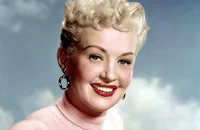Whoopee!
Brief Synopsis
Cast & Crew
Thornton Freeland
Eddie Cantor
Ethel Shutta
Paul Gregory
Eleanor Hunt
John Rutherford
Film Details
Technical Specs

Synopsis
Although Sally Morgan has long been in love with Wanenis, an Indian who lives near her father's ranch, her father has convinced her to become engaged to Sheriff Bob Wells while Wanenis is away being educated in the ways of the white man. Unwilling to go through with the marriage, Sally, who hopes to convince Wanenis to elope with her, prevails upon Henry Williams, a kind-hearted hypochondriac living on the ranch, to take her away in his ramshackle Ford. With her father and Wells in pursuit, Sally and Henry run out of gas, but steal fuel from a car belonging to Jerome Underwood, whose ranch they later go to for food. When Wells and his deputies arrive at the ranch, Henry, now working as the cook, disguises himself in blackface. Later he narrowly escapes the sheriff and takes refuge in an Indian reservation. Wanenis, believing that his race makes his love for Sally impossible, has abandoned white civilization, and Sally is about to be carried off by her father when Matafay, an Indian woman who is to marry Wanenis, forces Chief Black Eagle to reveal the truth, that he adopted Wanenis, who was the orphaned baby son of a white couple who died. Sally's father now consents to the marriage and Henry finally proposes to his devoted nurse, Mary Custer.

Director
Thornton Freeland
Cast

Eddie Cantor

Ethel Shutta
Paul Gregory
Eleanor Hunt
John Rutherford
Walter Law
Spencer Charters
Albert Hackett
Chief Caupolican
Lou-scha-enya
William H. Philbrick

Marilyn Morgan

Dean Jagger
George Olsen
Jeanne Morgan

Betty Grable

Virginia Bruce
Muriel Finley
Ernestine Mahoney
Christine Maple
Jane Keithley
Mary Ashcraft
Georgia Lerch
Betty Stockton
Crew
Busby Berkeley
Nacio Herb Brown
William M. Conselman
Richard Day
Walter Donaldson
Edward Eliscu
Lee Garmes
Samuel Goldwyn
Samuel Goldwyn
John Harkrider
Stuart Heisler
H. B. Humberstone
Gus Kahn
Oscar Lagerstrom
Alfred Newman
George Olsen
Ray Rennahan
Gregg Toland
United Costumers, Inc.
Florenz Ziegfeld
Florenz Ziegfeld

Film Details
Technical Specs

Award Nominations
Best Art Direction
Quotes
Oh, poor Henry. Let me hold your hand.- Mary Custer
It's not heavy. I can manage. Hold your own hand.- Henry Williams
Why do you make overtures to me when I need intermissions so badly?- Henry Williams
But they'll give you twenty years.- Sally Morgan
Twenty ye - ha ha ha ha ha ha...- Henry Williams
What are you laughing at?- Sally Morgan
Why, the joke's on them.- Henry Williams
Why?- Sally Morgan
I can't live but six months.- Henry Williams
Trivia
Notes
The opening title card reads: "Florenz Ziegfeld and Samuel Goldwyn Present Eddie Cantor in 'Whoopee!' A Musical Comedy of the Great Wide West Based on the Famous Stage Success. All Technicolor." The film ends after Cantor sings "My Baby Just Cares for Me" to "Mary Custer" (Ethel Shutta), then turns to the camera and says "That's All There Is." Cantor recreated his popular stage role, singing, among others, the hit title song, "Makin' Whoopee," which became one of his signature tunes. The song has been recorded many times since it was first introduced, often with added verses or slightly altered lyrics. At one point in the film, when Cantor's character, "Henry Williams," is preparing waffles, he briefly reprises the song, but changes the refrain to "I'm makin' waffles."
In addition to Cantor, Shutta, Paul Gregory, Albert Hackett, Spencer Charters, Chief Caupolican and John "Jack" Rutherford recreated their stage roles for the film. Eleanor Hunt, who portrayed "Sally Morgan" in the film, also appeared in the Broadway show, but only as a dancer in the chorus. The Broadway play also was produced by Florenz Ziegfeld, and featured costumes by John Harkrider, who also designed the film's costumes. Although both the Broadway show and the film featured several songs, only "Makin' Whoopee" was used in both. The biggest hit song from the Broadway show was "Love Me or Leave," which was sung by Ruth Etting and became her signature tune, as well as the title of the 1955 biographical film about her life.
Whoopee! included several lavish production numbers choreographed by Busby Berkeley (1895-1976), among them "Stetson" and "The Song of the Setting Sun," which featured a parade of the showgirls known as "The Goldwyn Girls" dressed in lavish costumes in a Native American theme. Some of the showgirls ride horseback as they descend a set constructed in the shape of a mountain. Whoopee! marked Berkeley's first film and brought to the screen his signature style of lavish production numbers featuring large choruses of beautiful women dancing in precision. During many of the numbers, the dancers were shot from above so that their costumes and movements would create the cinematic kaleidoscopes that were his trademark.
Whoopee! was shot in the two-strip Technicolor process. The Variety reviewer called it "the finest job Technicolor has set forth to date," and although he and other critics generally praised the film, most compared it unfavorably to the Broadway original. Art director Richard Day received an Academy Award nomination for the film.
According to a July 2, 1971 Daily Variety article, The Museum of Modern Art in New York had recently located a print of the film in a Czech film archive and would be working on a restoration and possible re-issue. According to the article, a print of the film had been kept in a Berlin archive, but when Russian troops took control of that section of the city in 1945, they took possession of the archive and subsequently transferred the original nitrate print onto safety stock using the Perranie color process. As noted in 1977 news items, when the film was revived for a Los Angeles showing that year, the racial stereotypes, including Cantor's sequence in blackface, were criticized. A June 1977 Los Angeles Times article stated that a new print of the film cost $15,000.












